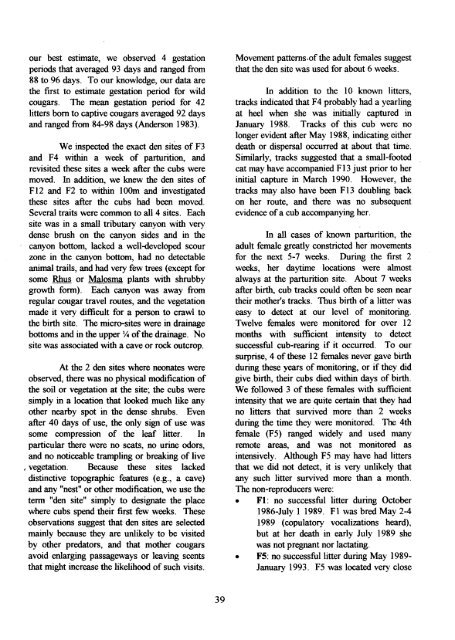the cougar in the santa ana mountain range, california
the cougar in the santa ana mountain range, california
the cougar in the santa ana mountain range, california
You also want an ePaper? Increase the reach of your titles
YUMPU automatically turns print PDFs into web optimized ePapers that Google loves.
our best estimate, we observed 4 gestation<br />
periods that averaged 93 days and <strong>range</strong>d from<br />
88 to 96 days. To our knowledge, our data are<br />
<strong>the</strong> first to estimate gestation period for wild<br />
<strong>cougar</strong>s. The mean gestation period for 42<br />
litters born to captive <strong>cougar</strong>s averaged 92 days<br />
and <strong>range</strong>d from 84-98 days (Anderson 1983).<br />
We <strong>in</strong>spected <strong>the</strong> exact den sites of F3<br />
and F4 with<strong>in</strong> a week of parturition, and<br />
revisited <strong>the</strong>se sites a week after <strong>the</strong> cubs were<br />
moved. In addition, we knew <strong>the</strong> den sites of<br />
F 12 and F2 to with<strong>in</strong> 100m and <strong>in</strong>vestigated<br />
<strong>the</strong>se sites after <strong>the</strong> cubs had been moved.<br />
Several traits were common to all 4 sites. Each<br />
site was <strong>in</strong> a small tributary canyon with very<br />
dense brush on <strong>the</strong> canyon sides and <strong>in</strong> <strong>the</strong><br />
canyon bottom, lacked a well-developed scour<br />
zone <strong>in</strong> <strong>the</strong> canyon bottom, had no detectable<br />
animal trails, and had very few trees (except for<br />
some Rhus or Malosma plants with shrubby<br />
growth form). Each canyon was away from<br />
regular <strong>cougar</strong> travel routes, and <strong>the</strong> vegetation<br />
made it very difficult for a person to crawl to<br />
<strong>the</strong> birth site. The micro-sites were <strong>in</strong> dra<strong>in</strong>age<br />
bottoms and <strong>in</strong> <strong>the</strong> upper Y4 of<strong>the</strong> dra<strong>in</strong>age. No<br />
site was associated with a cave or rock outcrop.<br />
At <strong>the</strong> 2 den sites where neonates were<br />
observed, <strong>the</strong>re was no physical modification of<br />
<strong>the</strong> soil or vegetation at <strong>the</strong> site; <strong>the</strong> cubs were<br />
simply <strong>in</strong> a location that looked much like any<br />
o<strong>the</strong>r nearby spot <strong>in</strong> <strong>the</strong> dense shrubs. Even<br />
after 40 days of use, <strong>the</strong> only sign of use was<br />
some compression of <strong>the</strong> leaf litter. In<br />
particular <strong>the</strong>re were no scats, no ur<strong>in</strong>e odors,<br />
and no noticeable trampl<strong>in</strong>g or break<strong>in</strong>g of live<br />
I vegetation. Because <strong>the</strong>se sites lacked<br />
dist<strong>in</strong>ctive topographic features (e.g., a cave)<br />
and any "nest" or o<strong>the</strong>r modification, we use <strong>the</strong><br />
term "den site" simply to designate <strong>the</strong> place<br />
where cubs spend <strong>the</strong>ir first few weeks. These<br />
observations suggest that den sites are selected<br />
ma<strong>in</strong>ly because <strong>the</strong>y are unlikely to be visited<br />
by o<strong>the</strong>r predators, and that mo<strong>the</strong>r <strong>cougar</strong>s<br />
avoid enlarg<strong>in</strong>g passageways or leav<strong>in</strong>g scents<br />
that might <strong>in</strong>crease <strong>the</strong> likelihood of such visits.<br />
39<br />
Movement pattems.of<strong>the</strong> adult females suggest<br />
that <strong>the</strong> den site was used for about 6 weeks.<br />
In addition to <strong>the</strong> 10 known litters,<br />
tracks <strong>in</strong>dicated that F4 probably had a yearl<strong>in</strong>g<br />
at heel when she was <strong>in</strong>itially captured <strong>in</strong><br />
January 1988. Tracks of this cub were no<br />
longer evident after May 1988, <strong>in</strong>dicat<strong>in</strong>g ei<strong>the</strong>r<br />
death or dispersal occurred at about that time.<br />
Similarly, tracks suggested that a small-footed<br />
cat may have accompanied F13 just prior to her<br />
<strong>in</strong>itial capture <strong>in</strong> March 1990. However, <strong>the</strong><br />
tracks may also have been F13 doubl<strong>in</strong>g back<br />
on her route, and <strong>the</strong>re was no subsequent<br />
evidence ofa cub accompany<strong>in</strong>g her.<br />
In all cases of known parturition, <strong>the</strong><br />
adult female greatly constricted her movements<br />
for <strong>the</strong> next 5-7 weeks. Dur<strong>in</strong>g <strong>the</strong> first 2<br />
weeks, her daytime locations .were almost<br />
always at <strong>the</strong> parturition site. About 7 weeks<br />
after birth, cub tracks could often be seen near<br />
<strong>the</strong>ir mo<strong>the</strong>r's tracks. Thus birth of a litter was<br />
easy to detect at our level of monitor<strong>in</strong>g.<br />
Twelve females were monitored for over 12<br />
months with sufficient <strong>in</strong>tensity to detect<br />
successful cub-rear<strong>in</strong>g if it occurred. To our<br />
surprise, 4 of<strong>the</strong>se 12 females never gave birth<br />
dur<strong>in</strong>g <strong>the</strong>se years of monitor<strong>in</strong>g, or if <strong>the</strong>y did<br />
give birth, <strong>the</strong>ir cubs died with<strong>in</strong> days of birth.<br />
We followed 3 of <strong>the</strong>se females with sufficient<br />
<strong>in</strong>tensity that we are quite certa<strong>in</strong> that <strong>the</strong>y had<br />
no litters that survived more than 2 weeks<br />
dur<strong>in</strong>g <strong>the</strong> time <strong>the</strong>y were monitored. The 4th<br />
female (F5) <strong>range</strong>d widely and used many<br />
remote areas, and was not monitored as<br />
<strong>in</strong>tensively. Although F5 may have had litters<br />
that we did not detect, it is very unlikely that<br />
any such litter survived more than a month.<br />
The non-reproducers were:<br />
• Fl: no successful litter dur<strong>in</strong>g October<br />
1986-July 1 1989. F1 was bred May 2-4<br />
1989 (copulatory vocalizations heard),<br />
but at her death <strong>in</strong> early July 1989 she<br />
was not pregnant nor lactat<strong>in</strong>g.<br />
• F5: no successful litter dur<strong>in</strong>g May 1989<br />
January 1993. F5 was located very close
















